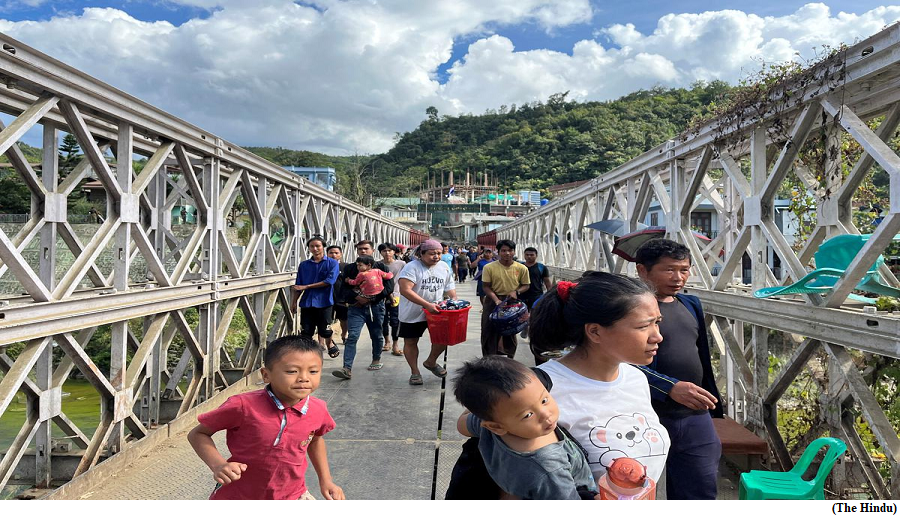Why are people fleeing Myanmar for Mizoram? (GS Paper 3, Internal Security)

Why in news?
- In a spillover of the civil war in Myanmar, more than 1,500 nationals took refuge in Mizoram’s Champhai district following a gunfight between the Myanmar Army, and pro-democracy militias in the western Chin State abutting Mizoram.
- Reports indicate that the attacks on the ruling military junta (or the Tatmadaw) involving the Chin National Army (CNA) and the Chin Defense Force among others led to the capture of two bases; the Khawmawi and Rihkhawdar military camps by the rebels.
What is the situation in Myanmar?
- The attacks in Chin State coincidentally followed a major coordinated attack on regime forces by three ethnic armed groups — the Myanmar National Democratic Alliance Army (MNDAA), Ta’ang National Liberation Army (TNLA) and the Arakan Army (AA) in Myanmar’s north Shan State abutting China.
- The coordinated attacks, termed “Operation 1027”, by the Three Brotherhood Alliance led to serious setbacks for the junta’s forces in Shan State and brought about a sequence of other rebel attacks including those in the Chin State.
- Scores of military outposts and bases were either abandoned by the junta forces or were captured by the rebels, with the UN stating that 60,000 people in Shan State and 2,00,000 overall in the country have been displaced.
What led to the current civil war?
- In February 2021, a new junta, the State Administration Council (SAC) dominated by the Myanmar armed forces, organised a military coup that ousted the civilian National League for Democracy-government and detained its leader Aung San Suu Kyi among many other legislators and party officials.
- The junta said it captured power because of irregularities in the November 2020 elections, even though international observers called the elections fair.
- The coup led to the collapse of the democratic phase that opened up after the 2008 Constitution.
- This Constitution allowed for reserving 25% of the Parliament of Myanmar for serving military officers, and control over home, border affairs and defence by the military, thereby limiting civilian powers.
- After the February 2021 coup, there were nationwide protests and civil disobedience campaigns, leading to the “Spring Revolution”.
NUCC:
- Members of the deposed NLD and other elected ethnic lawmakers formed a new political body called the Committee Representing Pyidaungsu Hluttaw (or National Parliament in Burmese), which along with other civil society actors, ethnic party representatives and others later formed the National Unity Consultative Council (NUCC), a dialogue platform seeking to unite pro-democratic forces.
- The NUCC agreed upon a “federal democratic charter” (FDC) that sought to come up with a future constitution, and a political roadmap to a “federal democratic” country to be led by a National Unity Government (NUG) that was announced in April 2021.
- A final publication of the FDC happened in March 2022, after incorporating ethnic demands of recognition and equality for non-Bamar minority identities.
- The junta responded by violently cracking down on the largely peaceful movement leading to the NUG announcing the creation of People’s Defense Forces (PDF), and in September 2021, explicitly gave the call for the PDF and other rebels to attack the junta, launching a civil war.
What has been the ethnic organisations’ response to the coup?
- The ethnic armed actors, despite coming under severe attack over the years from the Tatmadaw, have managed to establish autonomous enclaves in their areas.
- With the Tatmadaw unable to defeat them entirely, it signed ceasefires with groups that allowed them to retain arms and some autonomy in minority areas, a situation that persists even today.
- The ethnic armed groups’ responses to the insurrection call by the NUG have been varied.
- Groups such as the Karen (Karen National Union), Kachin (Kachin Independence Organization), Chin (Chin National Front) and Karenni (Karenni National Progressive Party) rebels support the NUG, fighting the army and helping forming anti-coup militias.
- They do so while rejecting a NUG proposal for a single “Federal Army’’ under unified NUG command.
How has China reacted?
- China, has leverage over some of the northern ethnic armed forces that are now engaged against the junta.
- While China has publicly called for a cessation in hostilities, experts aver that the Chinese are willing to tolerate the actions as the rebels have evinced interest in reining in illicit activities such as “telecom scam centres” in the Kokang zone.
- The MNDAA announced that it is planning to attack the Laukkai township in Kokang which is controlled by junta-affiliated militias and is also host to many cybercrime compounds.
- These illicit centres have trapped thousands of Chinese nationals besides many from Southeast Asia, forcing them to carry out internet fraud, theft and cybercrime activities targeting Chinese citizens and others.


